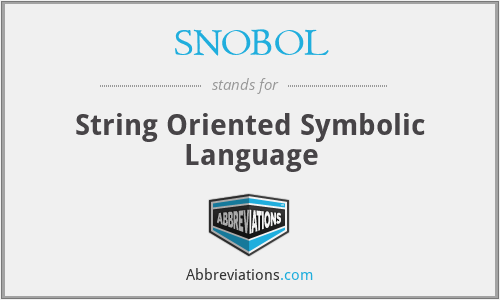What does SNOBOL mean in General Computing?
This page is about the meanings of the acronym/abbreviation/shorthand SNOBOL in the Computing field in general and in the General Computing terminology in particular.
Translation
Find a translation for String Oriented Symbolic Language in other languages:
Select another language:
- - Select -
- 简体中文 (Chinese - Simplified)
- 繁體中文 (Chinese - Traditional)
- Español (Spanish)
- Esperanto (Esperanto)
- 日本語 (Japanese)
- Português (Portuguese)
- Deutsch (German)
- العربية (Arabic)
- Français (French)
- Русский (Russian)
- ಕನ್ನಡ (Kannada)
- 한국어 (Korean)
- עברית (Hebrew)
- Gaeilge (Irish)
- Українська (Ukrainian)
- اردو (Urdu)
- Magyar (Hungarian)
- मानक हिन्दी (Hindi)
- Indonesia (Indonesian)
- Italiano (Italian)
- தமிழ் (Tamil)
- Türkçe (Turkish)
- తెలుగు (Telugu)
- ภาษาไทย (Thai)
- Tiếng Việt (Vietnamese)
- Čeština (Czech)
- Polski (Polish)
- Bahasa Indonesia (Indonesian)
- Românește (Romanian)
- Nederlands (Dutch)
- Ελληνικά (Greek)
- Latinum (Latin)
- Svenska (Swedish)
- Dansk (Danish)
- Suomi (Finnish)
- فارسی (Persian)
- ייִדיש (Yiddish)
- հայերեն (Armenian)
- Norsk (Norwegian)
- English (English)
Definition
What does SNOBOL mean?
- SNOBOL
- SNOBOL ("StriNg Oriented and symBOlic Language") is a series of computer programming languages developed between 1962 and 1967 at AT&T Bell Laboratories by David J. Farber, Ralph E. Griswold and Ivan P. Polonsky, culminating in SNOBOL4. It was one of a number of text-string-oriented languages developed during the 1950s and 1960s; others included COMIT and TRAC. SNOBOL4 stands apart from most programming languages of its era by having patterns as a first-class data type (i.e. a data type whose values can be manipulated in all ways permitted to any other data type in the programming language) and by providing operators for pattern concatenation and alternation. SNOBOL4 patterns are a type of object and admit various manipulations, much like later object-oriented languages such as JavaScript whose patterns are known as regular expressions. In addition SNOBOL4 strings generated during execution can be treated as programs and either interpreted or compiled and executed (as in the eval function of other languages). SNOBOL4 was quite widely taught in larger US universities in the late 1960s and early 1970s and was widely used in the 1970s and 1980s as a text manipulation language in the humanities. In the 1980s and 1990s its use faded as newer languages such as AWK and Perl made string manipulation by means of regular expressions fashionable. SNOBOL4 patterns subsume BNF grammars, which are equivalent to context-free grammars and more powerful than regular expressions. The "regular expressions" in current versions of AWK and Perl are in fact extensions of regular expressions in the traditional sense, but regular expressions, unlike SNOBOL4 patterns, are not recursive, which gives a distinct computational advantage to SNOBOL4 patterns. (Recursive expressions did appear in Perl 5.10, though, released in December 2007.) One of the designers of SNOBOL, Ralph Griswold, designed successors to SNOBOL4 called SL5 and Icon, which combined the backtracking of SNOBOL4 pattern matching with more standard ALGOL-like structuring, as well as adding some features of their own.
Embed
Citation
Use the citation below to add this abbreviation to your bibliography:
Style:MLAChicagoAPA
"SNOBOL." Abbreviations.com. STANDS4 LLC, 2024. Web. 1 May 2024. <https://www.abbreviations.com/term/47159>.



Discuss this SNOBOL abbreviation with the community:
Report Comment
We're doing our best to make sure our content is useful, accurate and safe.
If by any chance you spot an inappropriate comment while navigating through our website please use this form to let us know, and we'll take care of it shortly.
Attachment
You need to be logged in to favorite.
Log In